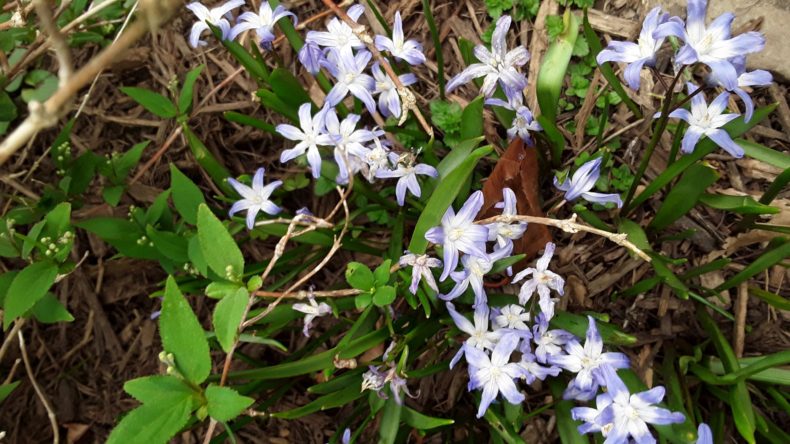
The flowers that bloom in the spring tra la. I love them faintingly, I gaze at them, hands folded reverently, such dears they are, oh my darlings, my minor bulbs!
Minor bulbs are not the same as spring ephemerals — really their name — like spring beauties, dog-tooth violets, may apples, shooting stars, and Dutchman’s breeches, their names alone are a song. They grow in woods and each one is so delicate, so oh-please-stay-awhile that they break your heart when in the next minute they’re gone. I’ve tried planting these and it never works.
Neighbors and passers-by say how beautiful are the daffodils-narcissi-hyacinths, which I also love though more prosaically. Thank you, I say, but come look at my minor bulbs. Oh nice, say the neighbors and passers-by, and continue having transports over the major bulbs. But look at this one, I say, it’s called Chionodoxa, chion meaning glory and doxa meaning glory, snow glory, glory of the snow, see how the white centers fade into the blue petals, so interesting! The fact is, minor bulbs seem to interest no one but me.
For years I ignored them in the catalogs — minor, unworthy of my attention, and dirt cheap. The catalogs say to plant them in masses and drifts so you notice them. I don’t know about that: I’m kind of a minor bulb myself but I wouldn’t be better drifting all over the landscape.
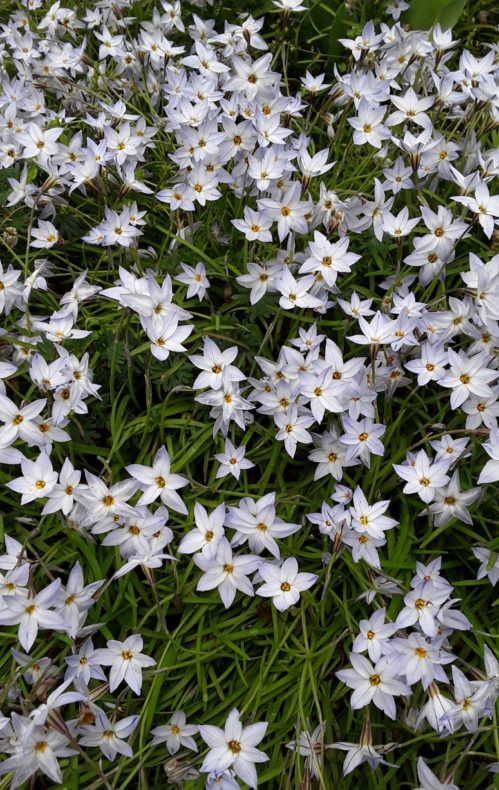
The first one I planted was Ipheion uniflorum, this variety called Wisley blue, Wisley being a Victorian businessman who planted an experimental garden. I can’t find out what Ipheion means (“Genus name origin is unclear,” says the Missouri Botanical Gardens) but the word looks Greek and if anyone knows I’d be so happy to hear it; uniflorum is one flower. So I planted maybe 5 of them so I could look at each one flower. But their character is such that they like their own company and they spread like water — I don’t know how because they’re bulbs — and now I have hundreds. I not only don’t know what Ipheion means, I can’t pronounce it so I call them Wisley blues. I step outside on a spring morning and yell, “Good morning, Wisley blues!” as loud as I can.
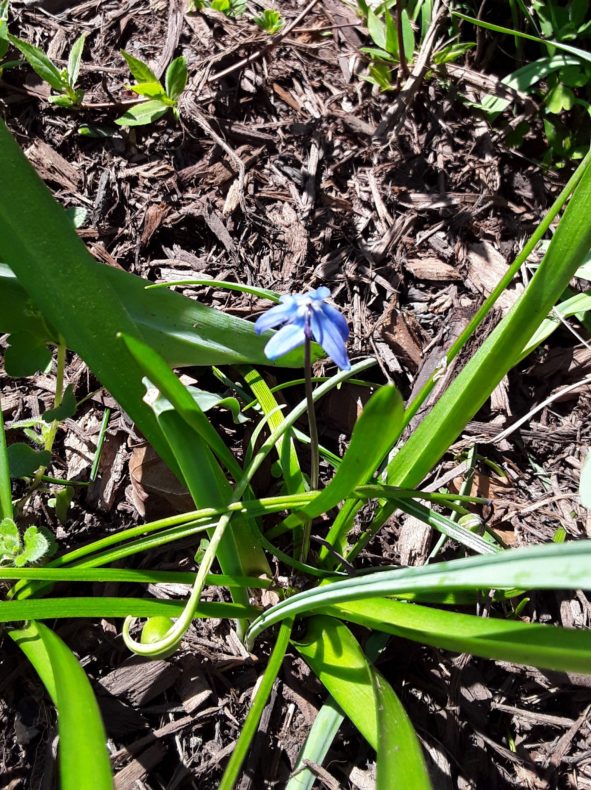
This little one is Scilla siberica, Siberian squill; a random internet source says scilla is Greek for exciting, which, hardly; the scillas/squills are a big family that includes lots of bluebell-like things. I planted this one inadvertently when I’d dug up, semi-legally, some huge naturalized snowdrops in a woods not obviously owned by anyone, and the little scilla came along. I’m not proud of my short career in piracy but I’m not giving this back. The scilla family spreads but this one hasn’t, just a few quiet, modest characters here and there, small but so intense and indigo you have to look at them. Such precision they have and so brave because early spring is not the kindest time of year.
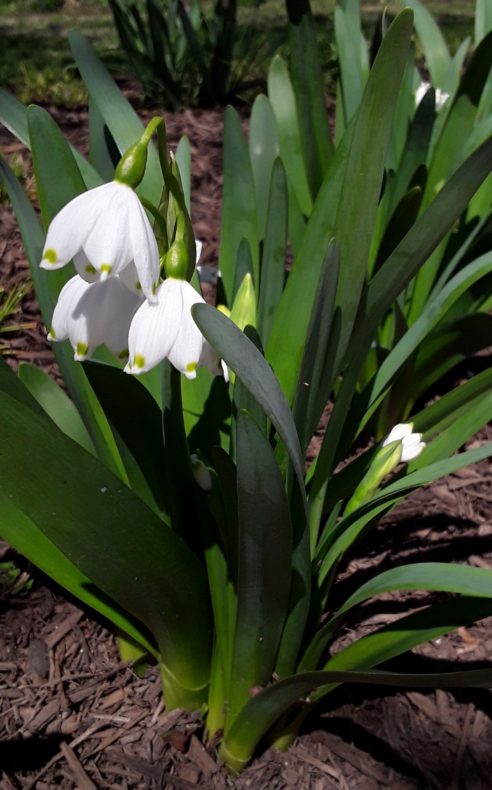
I saw this one in a catalog — it’s Leucojum aestivum, called ‘Gravetye Giant’ after an Irish garden writer whose house was Gravetye Manor. Leuco means white and I don’t know what jum has to do with it; aestivum is summer. Summer whites. I had trouble taking this picture because it was a little windy out and those heavy bells kept swinging back and forth; they should have made dinging sounds. The little green dots could have been put there by some Arts & Crafts artist. Leucojum is much bigger than the other minor bulbs, a foot or so tall, dignified, very much a social presence. So while most of my minor bulbs are near the house where I can see their precision, leucojum is out by the sidewalk where it can be appreciated by people walking fast. It does like to be appreciated.
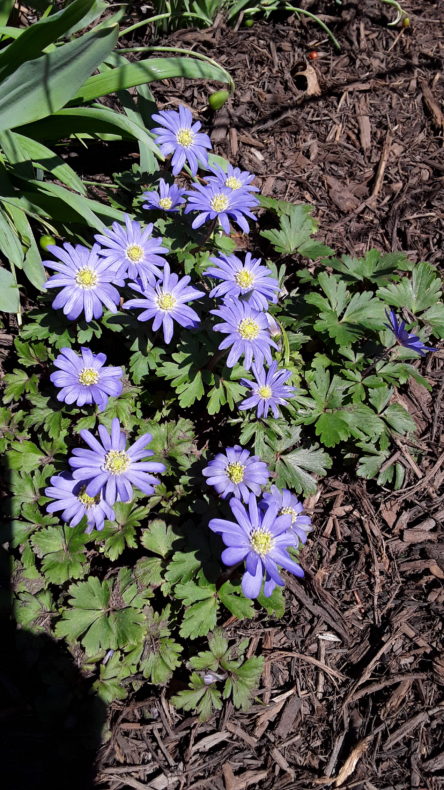
Anemone blanda, anemone is Greek for wind and like the leucojum, it blows around a bit; blanda is mild and pleasing; a mild wind flower. I tried planting these years ago and maybe they showed up once; tried again, no show, gave up. Read up on them, discovered that right after planting (shallow) they get eaten by squirrels. I was irate, felt disrespected, rose to the challenge, and ordered them again. Took advice: doubled-up old chicken wire, folded it into a tube, put the anemone tubers inside, stitched the tube together with wire, planted the whole thing, and watched hell-bent squirrel-holes appear in the mulch. They may have gotten some of them, I don’t know, but not all of them. NOT ALL OF THEM, YOU GREEDY BEADY-EYED RAT-BASTARDS! VICTORY IS MINE!
Minor bulbs: prayers, pleasures, and righteous fury, at pennies per shot.
________
Photos by me, and I wish they were better but that would mean getting an actual camera and learning to use it. Any reliable information has come from the website of the Missouri Botanical Gardens, an institution which is a gift unto us all.
Your anemone blanda prompted an “ah Ha!” From me. I wish I could post a pic here, because I had to rush out and double check – that is exactly what simply appeared at the foot of my white oak several years ago. You’re not in SC are you? Perhaps the squirrels dug yours up and forgot they stashed them here. Anyway, I have long loved them!
Not in SC, in Baltimore. I bet squirrels are exactly responsible for the anemones under your tree. According to the internet, by the second year the bulbs get big enough that the squirrels don’t bother with them. Glad to have this minor bulb conversation.
I love the Missouri Botanical Garden (love the acronym Mobot). I have even visited there. The knowledge residing there is truly wonderful. I planted scilla in large groups several years ago. They come up now less enthusiastically blue and in fewer numbers. Could be the squirrels. I am sure the squirrels are responsible for the crocuses which were planted around a tree and now appear in unexpectedly across my yard. It is a pleasure to suddenly see dots of purple and gold in random new locations.
Squirrels have done that to my crocuses too — squirrel gardening — and you’re more forgiving of them than I am.
I sure enjoyed reading about Minor Bulbs and other things! Very entertaining and taught me something…I need to learn the names of the flowers coming up in my yard. I didn’t plant them, and they just appeared. I thought they were snow crocuses, but I think I’m wrong, because I saw a similar flower in your article. In my hometown, they have a Spring Wildflower Festival!
Very cute – and a lovely thing to write about. Tiny point: Wisley is more than a minor businessman who planted a garden – it’s the research garden of the Royal Horticultural Society
https://www.rhs.org.uk/gardens/wisley
Wow, Adam! Plus he had a name that’s so much fun to say, especially added to “blues.” You could sing yourself to sleep with Wisley blues.